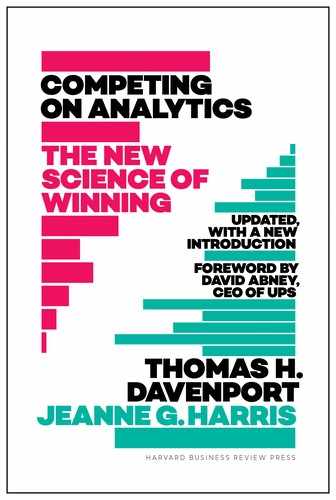FOREWORD
I’m convinced that complacency poses one of the most serious threats to any business. Companies so intent on staying the course that they don’t hear the footsteps behind them pay a high price for misguided satisfaction. Photographic film companies didn’t fully appreciate the threat created by digital photography, and probably even less that it would come from smartphones. Newspapers dependent on classified ads didn’t react proactively to online sites like Craigslist. Movie rental companies didn’t react fast enough to streaming companies like Netflix.
The story is almost always the same. Winners become also-rans, and eventually case studies, because it was easier to keep doing the things that made them winners in the first place. The path of least resistance was more comfortable than challenging whether what built success would be enough to sustain it.
The founder of UPS, Jim Casey, knew the dangers of complacency and advocated for what he called “constructive dissatisfaction.” Time and again, Casey restructured and reinvented UPS to counter a host of competitive threats. Over time, one of our biggest competitive advantages came from our early adoption of analytics as a means of continuously assessing and improving every facet of our business.
Analytics enabled us to design one of the first handheld devices, which we put in the hands of every one of our drivers in 1990. To truly harness the power of these devices, we had to kludge together what were then largely regional cellular networks into a proprietary network that covered the United States. That enabled us to gather information on the movement of every package in our system, which in turn helped us build one of the largest data warehouses in the world. The insights we gained via analytics enabled us to achieve new levels of efficiency and to share this learning with customers.
Given a taste of what was possible, our hunger for analytics grew. We created a suite of tools built on predictive models we called Package Flow Technologies. Deployed in 2003, these tools reduced 85 million miles annually. And by opening up our predictive engines to customers and giving them the same information we had, they could interact with our operations directly and personalize their delivery experience.
But for us the analytics jackpot is a prescriptive analytics model we named ORION (short for On-Road Integrated Optimization and Navigation), which tells our drivers which route they should follow to make their deliveries using the least amount of time—and fuel. It’s not an overstatement to say that ORION has revolutionized our business. In Competing on Analytics, the book now in your hands, Tom Davenport and Jeanne Harris call ORION the “granddaddy” of real-time applications and say it “may be the largest commercial analytics project ever undertaken.”
Before the digital revolution took hold, our managers laid out our drivers’ routes with pushpins on maps inside our package hubs. Then we transferred that information to our drivers’ handheld computers. Drivers were taught to follow pretty much the same route every day, delivering our commercial stops first and then their residential stops, because commercial customers were typically more demanding.
But with the e-commerce revolution, residential customers wanted more control over when and where their packages were delivered. Trying to meet the needs of both commercial and residential customers often meant drivers were crossing the same path multiple times, wasting time and fuel.
Our drivers were good at their jobs, and their customers loved them for their reliability and trustworthiness. But we foresaw a day when our drivers could not wring one more second of efficiency out of their routes. When their best would be our best. Then what would we do? (You have to remember these were the days before IBM’s Watson was a Jeopardy champion and before we carried the computing power of early mainframes in our pocket.) What’s more, some people in our company thought no computer could improve on what experienced UPS drivers already did so well.
Fortunately, our engineers created a thirty-page algorithm that allows us to determine the optimum route for each of our fifty-five thousand drivers to make their deliveries each day. ORION now shortens each driver’s daily route by an average of seven to eight miles, which collectively saves us 100 million miles and 10 million gallons of fuel a year. All told, ORION generates more than $400 million in annual cost savings and avoidance for UPS.
In the process, we have realized the data we collect as a package flows through our network is often as valuable to the customer as the package itself. Based on data extracted from our network, customers are improving their business processes and making more informed decisions, which makes UPS a more valuable partner.
For years, our advertising proclaimed UPS as the company that loved logistics. We still love logistics, but we’re forever indebted to analytics. And we’ve since expanded our use of analytics beyond optimizing our physical network, applying it in many other facets of our business.
This revised and expanded version of Tom and Jeanne’s earlier work brings the analytics story forward, with new applications, insights, and forecasts. The authors show how analytics continues to transform technology from a supporting tool to a strategic advantage.
In Competing on Analytics, the authors not only introduced business leaders to analytics, they also made them analytical competitors, intimately attuned to its business and strategic value. Michael Lewis’ book Moneyball may have made analytics cool (with a little help from Brad Pitt), but it took Tom Davenport and Jeanne Harris to make it a business imperative.
